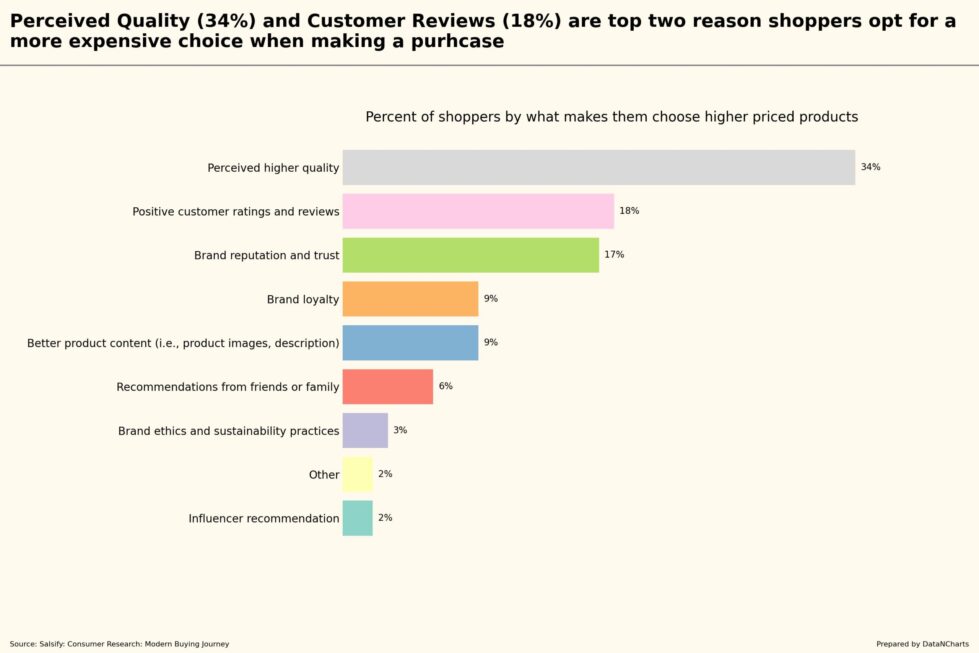Data Highlights
More than one in three (34%) shoppers choose higher-priced products based on perceived quality.
Nearly one in five shoppers rely on positive customer ratings (18%) and brand reputation (17%) when selecting a more expensive product.
Less than one in ten (9%) chooses premium options due to brand loyalty or better product content.
A negligible share considers recommendations from friends or family (6%), brand ethics and sustainability practices (3%), influencer endorsements (2%), or other minor reasons (2%) when selecting higher-priced products.
Scope
As competition in e-commerce increases, brands must understand why shoppers willingly pay more for certain products. Perceived quality remains the biggest driver, but trust, reviews, and brand reputation also influence purchase decisions. This brief examines key shopper motivations and offers insights for brands looking to justify premium pricing.
Perceived Quality Is the Biggest Driver of Premium Purchases (34%)
More than one in three (34%) shoppers choose higher-priced products based on perceived quality. Shoppers associate price with superior materials, durability, and performance. Brands must reinforce this perception through high-quality product descriptions, customer testimonials, and comparisons that highlight key product advantages.
Trust factors also play a significant role in premium product selection.
Customer Reviews and Brand Reputation Influence Premium Purchases (18%, 17%)
Nearly one in five (18%) shoppers consider positive customer ratings when selecting a higher-priced product. A similar share (17%) trusts the brand’s reputation when making a purchase. Retail analytics and data show that strong reviews and consistent branding help justify premium pricing. Brands should highlight top-rated products and maintain a strong, consistent presence across digital and physical sales channels.
Beyond trust and reputation, some shoppers are influenced by brand familiarity and content.
Brand Loyalty and Product Content Play a Smaller Role (9%)
A negligible share (9%) of shoppers choose premium options based on brand loyalty or better product content. While these factors contribute to decision-making, they do not drive most premium purchases. Brands should ensure high-quality images and clear descriptions to reinforce value perception but should not rely solely on content to justify higher prices.
Social proof remains relevant but is not a primary decision-maker for premium products.
Social Proof From Friends and Ethical Practices Have Limited Influence (6%, 3%)
A negligible share (6%) of shoppers rely on recommendations from friends or family when choosing a more expensive option. An even smaller share (3%) considers brand ethics and sustainability. While these factors strengthen long-term brand loyalty, they are not the main reasons shoppers pay more for a product.
Influencer marketing plays the smallest role in premium purchase decisions.
Influencer Recommendations Have Minimal Impact (2%)
A negligible share (2%) of shoppers choose premium options due to influencer endorsements. This suggests that while influencers raise awareness, they do not drive high-ticket conversions. Brands should focus more on product quality messaging and customer validation rather than influencer campaigns to justify premium pricing.
Insights and Opportunities
Understanding why shoppers choose premium products helps brands refine their pricing and marketing strategies.
- Firstly, brands must focus on product quality validation. Reinforcing quality through detailed product descriptions, comparison charts, and material specifications strengthens consumer confidence. Brands highlighting quality will see increased willingness to pay premium prices, higher conversion rates, and improved repeat purchase behavior. Key performance indicators (KPIs) include price elasticity, conversion rate increases, and return rate reductions.
- Secondly, customer ratings and brand reputation must be actively managed. Encouraging verified reviews, responding to feedback, and maintaining a strong brand image improve purchase confidence. Brands investing in trust-building strategies will see improved customer retention, higher average order values, and stronger premium product adoption. KPIs include review volume growth, trust score improvements, and repeat purchase rates.
- Finally, brands should optimize product presentation and value storytelling. High-resolution images, in-depth product descriptions, and side-by-side comparisons help shoppers justify paying more. Brands using these tactics can expect increased customer engagement, improved product discovery, and greater perceived value. KPIs include product page dwell time, engagement rates, and add-to-cart conversions for premium products.
By focusing on quality perception, trust-building, and value communication, brands can better position themselves to attract and retain shoppers willing to pay more.
